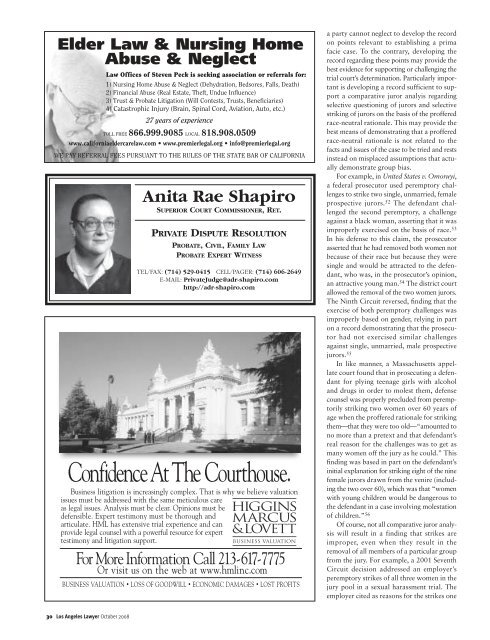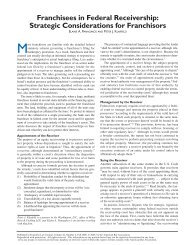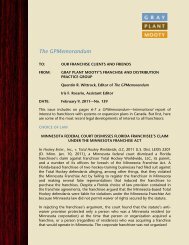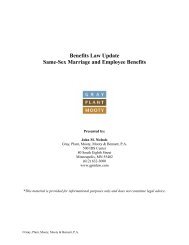Los Angeles Lawyer October 2008 - Gray Plant Mooty
Los Angeles Lawyer October 2008 - Gray Plant Mooty
Los Angeles Lawyer October 2008 - Gray Plant Mooty
Create successful ePaper yourself
Turn your PDF publications into a flip-book with our unique Google optimized e-Paper software.
Elder Law & Nursing Home<br />
Abuse & Neglect<br />
Law Offices of Steven Peck is seeking association or referrals for:<br />
1) Nursing Home Abuse & Neglect (Dehydration, Bedsores, Falls, Death)<br />
2) Financial Abuse (Real Estate, Theft, Undue Influence)<br />
3) Trust & Probate Litigation (Will Contests, Trusts, Beneficiaries)<br />
4) Catastrophic Injury (Brain, Spinal Cord, Aviation, Auto, etc.)<br />
27 years of experience<br />
TOLL FREE 866.999.9085 LOCAL 818.908.0509<br />
www.californiaeldercarelaw.com • www.premierlegal.org • info@premierlegal.org<br />
WE PAY REFERRAL FEES PURSUANT TO THE RULES OF THE STATE BAR OF CALIFORNIA<br />
ConfidenceAt The Courthouse.<br />
Business litigation is increasingly complex. That is why we believe valuation<br />
issues must be addressed with the same meticulous care<br />
as legal issues. Analysis must be clear. Opinions must be<br />
defensible. Expert testimony must be thorough and<br />
articulate. HML has extensive trial experience and can<br />
provide legal counsel with a powerful resource for expert<br />
testimony and litigation support.<br />
For More Information Call 213-617-7775<br />
Or visit us on the web at www.hmlinc.com<br />
BUSINESS VALUATION • LOSS OF GOODWILL • ECONOMIC DAMAGES • LOST PROFITS<br />
a party cannot neglect to develop the record<br />
on points relevant to establishing a prima<br />
facie case. To the contrary, developing the<br />
record regarding these points may provide the<br />
best evidence for supporting or challenging the<br />
trial court’s determination. Particularly important<br />
is developing a record sufficient to support<br />
a comparative juror analyis regarding<br />
selective questioning of jurors and selective<br />
striking of jurors on the basis of the proffered<br />
race-neutral rationale. This may provide the<br />
best means of demonstrating that a proffered<br />
race-neutral rationale is not related to the<br />
facts and issues of the case to be tried and rests<br />
instead on misplaced assumptions that actually<br />
demonstrate group bias.<br />
For example, in United States v. Omoruyi,<br />
a federal prosecutor used peremptory challenges<br />
to strike two single, unmarried, female<br />
prospective jurors. 52 The defendant challenged<br />
the second peremptory, a challenge<br />
against a black woman, asserting that it was<br />
improperly exercised on the basis of race. 53<br />
In his defense to this claim, the prosecutor<br />
asserted that he had removed both women not<br />
because of their race but because they were<br />
single and would be attracted to the defendant,<br />
who was, in the prosecutor’s opinion,<br />
an attractive young man. 54 The district court<br />
allowed the removal of the two women jurors.<br />
The Ninth Circuit reversed, finding that the<br />
exercise of both peremptory challenges was<br />
improperly based on gender, relying in part<br />
on a record demonstrating that the prosecutor<br />
had not exercised similar challenges<br />
against single, unmarried, male prospective<br />
jurors. 55<br />
In like manner, a Massachusetts appellate<br />
court found that in prosecuting a defendant<br />
for plying teenage girls with alcohol<br />
and drugs in order to molest them, defense<br />
counsel was properly precluded from peremptorily<br />
striking two women over 60 years of<br />
age when the proffered rationale for striking<br />
them—that they were too old—“amounted to<br />
no more than a pretext and that defendant’s<br />
real reason for the challenges was to get as<br />
many women off the jury as he could.” This<br />
finding was based in part on the defendant’s<br />
initial explanation for striking eight of the nine<br />
female jurors drawn from the venire (including<br />
the two over 60), which was that “women<br />
with young children would be dangerous to<br />
the defendant in a case involving molestation<br />
of children.” 56<br />
Of course, not all comparative juror analysis<br />
will result in a finding that strikes are<br />
improper, even when they result in the<br />
removal of all members of a particular group<br />
from the jury. For example, a 2001 Seventh<br />
Circuit decision addressed an employer’s<br />
peremptory strikes of all three women in the<br />
jury pool in a sexual harassment trial. The<br />
employer cited as reasons for the strikes one<br />
30 <strong>Los</strong> <strong>Angeles</strong> <strong>Lawyer</strong> <strong>October</strong> <strong>2008</strong>







